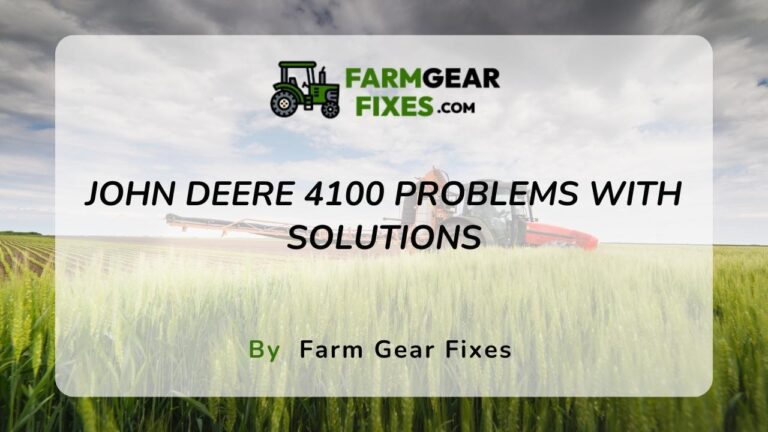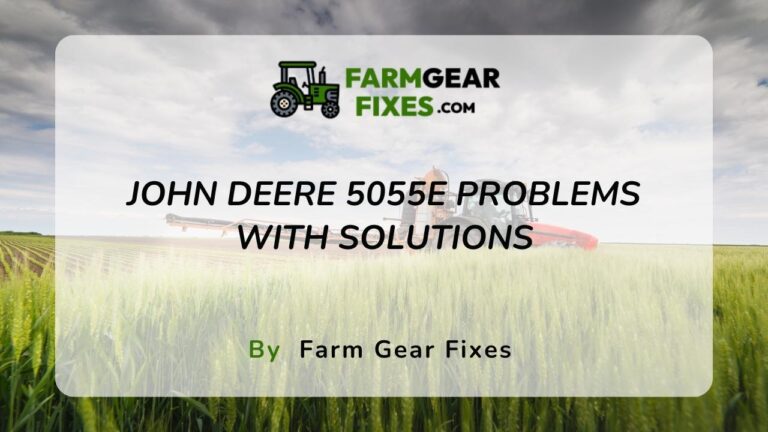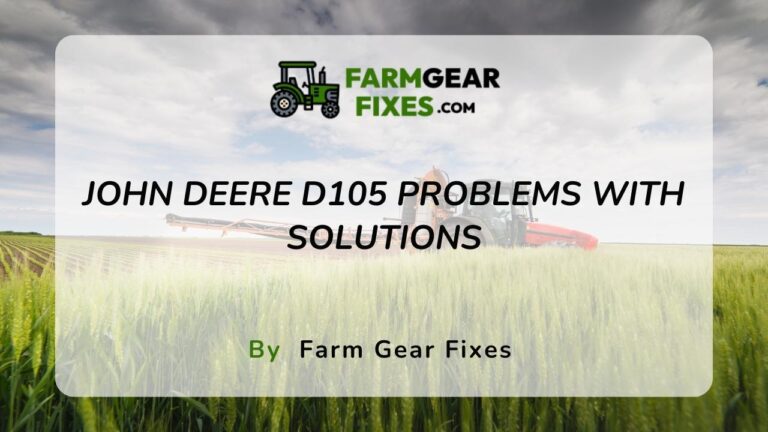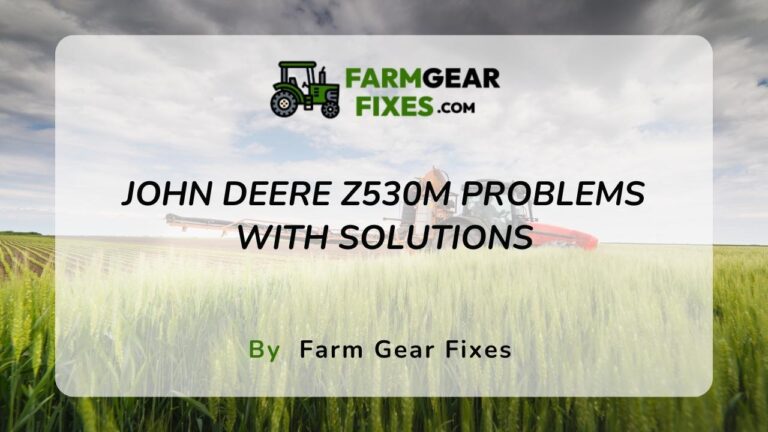7 Common John Deere 2010 Problems (Solutions Included)
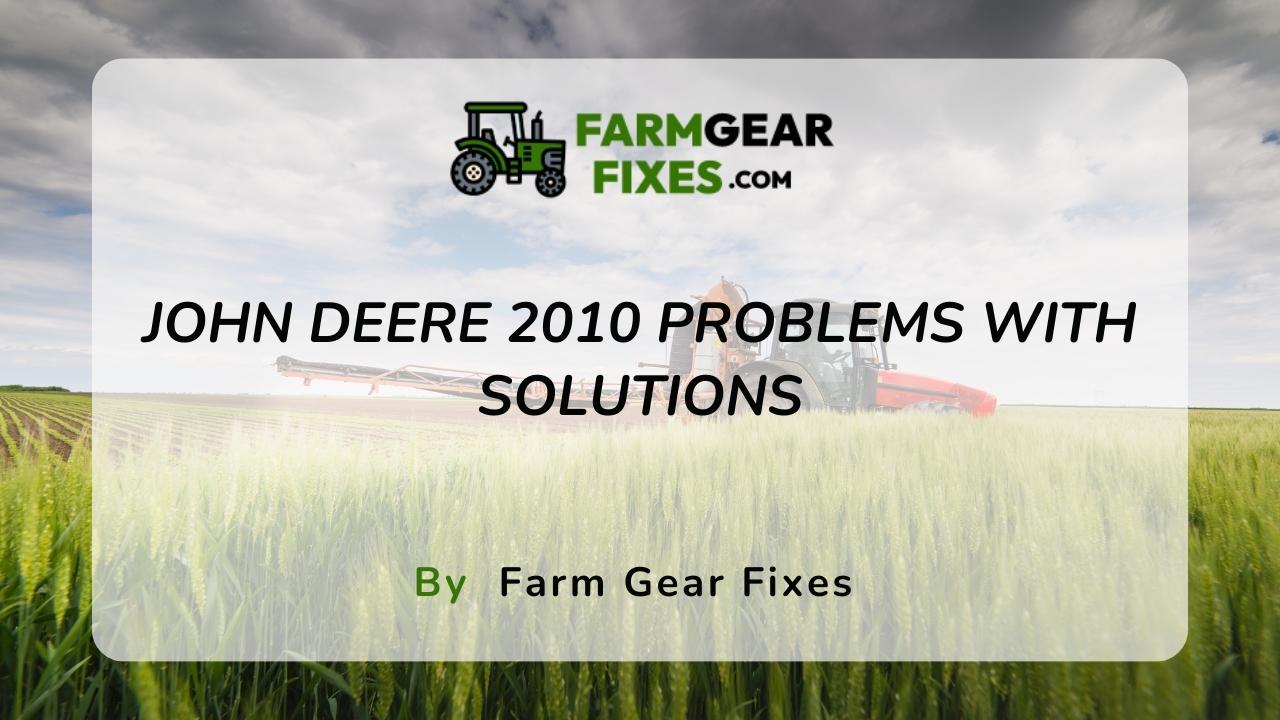
The John Deere 2010 is renowned among agricultural machinery enthusiasts for its reliability and impressive power. However, like any piece of equipment, it is prone to its own set of problems.
In this informative blog post, we will delve into some common issues that owners of the John Deere 2010 may encounter, and provide practical solutions to keep this workhorse running smoothly.
Whether it’s an issue with the engine, transmission, or hydraulics, we’ve got you covered with expert advice and tips to troubleshoot and resolve these problems effectively. Read on to ensure that your John Deere 2010 remains in top-notch condition for all your farming needs.
Historical Issues and Modern Impact
The John Deere 2010 has had its fair share of historical problems, but they have also shaped the way this tractor is used in modern times. Understanding the historical issues and their impact on current usage is crucial for anyone looking to maintain or operate a John Deere 2010.
Common Problems Historical Overview
With its release in the 1960s, the John Deere 2010 faced common problems such as engine overheating, hydraulic system leaks, and issues with the electrical system. These problems often led to reduced efficiency and increased maintenance costs for owners. Despite these challenges, the John Deere 2010 remained a popular choice for farmers and continues to be used today.
Impact on Current John Deere 2010 Usage
The historical problems of the John Deere 2010 have had a significant impact on its current usage. Many of the issues that plagued the tractor in the past have been addressed through modern advancements in technology and engineering. This has led to improved performance, reliability, and overall functionality of the John Deere 2010.
Impact on the current John Deere 2010 usage has been evident with the implementation of new solutions, such as improved cooling systems and upgraded hydraulic components, to address historical issues and enhance the tractor’s capabilities.
Engine and Starting Difficulties
The engine is the heart of any tractor, and having issues with it can be frustrating and costly. Engine and starting difficulties are common problems with John Deere 2010 tractors, but some solutions can help get your machine back up and running smoothly.
1) Diagnosing the Engine Problems
Engine problems can manifest in various ways, including hard starting, rough idling, and loss of power. It’s important to diagnose the issue correctly before attempting any repairs.
Common causes of engine problems in John Deere 2010 tractors include fuel system issues, ignition system problems, and mechanical issues such as worn-out parts or low compression.
Step-by-Step Troubleshooting
One way to troubleshoot engine and starting difficulties is to follow a step-by-step process. By systematically checking different components and systems, you can narrow down the root cause of the problem. Use the table below for a structured approach to troubleshooting these issues.
Step-by-Step Troubleshooting
| Step 1 | Check the fuel system for clogs or leaks |
| Step 2 | Inspect the ignition system for faulty components |
| Step 3 | Examine the air intake system for blockages |
| Step 4 | Test compression levels in the engine |
Troubleshooting the engine and starting difficulties requires patience and attention to detail. By following a structured approach and systematically checking different components, you can effectively pinpoint and resolve the issue. It’s important to use the right tools and techniques for accurate diagnosis and successful repairs.
Transmission and Hydraulic System Issues
Your John Deere 2010 may experience issues with its transmission and hydraulic system. These issues can significantly impact the performance and functionality of your tractor. However, there are solutions available to address these problems and ensure that your John Deere 2010 operates smoothly and efficiently.
2) Transmission Complications and Fixes
Issues with the transmission of your John Deere 2010 can manifest in various ways, such as gears slipping, difficulty shifting, or unusual noises during operation. These complications can stem from low or contaminated transmission fluid, worn-out clutch components, or problems with the transmission linkage.
To address these issues, it is important to regularly check and change the transmission fluid, inspect and replace worn-out clutch components, and adjust the transmission linkage as needed. Additionally, ensuring proper alignment and adjustment of the transmission can help alleviate these problems and enhance the overall performance of your tractor.
3) Hydraulic System Malfunctions and Solutions
Transmission issues can also affect the hydraulic system of your John Deere 2010, leading to malfunctions such as ineffective or jerky hydraulic response, leakage, or unresponsiveness of the hydraulic controls. These malfunctions may be caused by air or contaminants in the hydraulic fluid, damaged or worn-out hydraulic hoses, or faulty hydraulic valves.
To address these issues, it is important to bleed the hydraulic system, replace damaged hoses, and inspect and repair hydraulic valves as necessary. Regular maintenance and proper care of the hydraulic system can prevent these malfunctions and ensure optimal performance of your tractor’s hydraulic system.
System malfunctions related to the hydraulic system of your John Deere 2010 can significantly impact its overall performance and functionality.
By addressing transmission and hydraulic system issues proactively and implementing the appropriate solutions, you can maintain the optimal performance of your tractor and ensure its longevity and reliability. Regular inspection, maintenance, and timely repairs are essential to prevent these issues and keep your John Deere 2010 in top working condition.
Electrical System and Fuel Problems
Now, let’s address some of the common issues that arise with the electrical system and fuel system of the John Deere 2010, and how to effectively troubleshoot and fix these problems.
4) Electrical Failures and Repair Procedures
To ensure the proper functioning of the John Deere 2010, it is essential to be aware of potential electrical failures that may occur. Some of the common issues include faulty wiring, blown fuses, and malfunctioning components such as the starter or alternator.
When encountering these problems, it is crucial to conduct a thorough inspection of the electrical system, checking for any loose connections, damaged wires, or worn-out parts. Repair procedures may involve replacing damaged components, testing the voltage, and ensuring proper grounding to prevent further issues.
5) Fuel System Challenges and Remediation
System malfunctions within the fuel system of the John Deere 2010 can significantly impact its performance. Fuel system challenges may include issues with the fuel pump, clogged filters, or fuel contamination.
To address these challenges, it is important to conduct regular maintenance, such as cleaning or replacing fuel filters and inspecting the fuel lines for any blockages or leaks. Additionally, ensuring the proper fuel quality and storage practices can prevent fuel contamination, which can lead to engine issues and reduced performance.
It is imperative to address these electrical and fuel system problems promptly to avoid further damage to the John Deere 2010. Regular maintenance and proactive troubleshooting can help maintain the reliability and efficiency of the machine, ensuring optimal performance in the long run.
Undercarriage and PTO Concerns
To ensure the smooth functioning of your John Deere 2010, it is crucial to address undercarriage and PTO concerns.
Neglecting these areas can lead to costly repairs and downtime. In this section, we will discuss common problems related to undercarriage and PTO, as well as their respective solutions.
6) Maintenance of Undercarriage Components
The undercarriage of your John Deere 2010 is subjected to heavy wear and tear, especially when operating in challenging terrains. Regular maintenance of undercarriage components is essential to ensure optimal performance and longevity.
The tracks, idlers, rollers, and sprockets should be inspected for signs of wear, and any damaged or worn-out parts should be replaced promptly. Additionally, lubrication of undercarriage components should be carried out according to the manufacturer’s recommendations to minimize friction and extend the lifespan of the parts.
7) Power Take-Off (PTO) Malfunctions and Fixes
Malfunctions in the power take-off (PTO) system can disrupt your John Deere 2010’s ability to perform various tasks, such as powering implements and attachments. Common PTO issues may include PTO shaft slippage, failure to engage, or unusual noises during operation.
To address these problems, start by inspecting the PTO shaft for any signs of damage or misalignment. Additionally, check the PTO clutch and its components for wear and proper adjustment. In some cases, PTO malfunctions can be resolved by simply adjusting the clutch or replacing worn-out parts.
It is vital to address PTO issues promptly to prevent further damage to the system and ensure the uninterrupted operation of your equipment.
Undercarriage and PTO concerns should not be overlooked when maintaining your John Deere 2010. Proper care and timely attention to these components can contribute to the overall performance and reliability of your equipment. By implementing regular inspections and following the recommended maintenance schedule, you can avoid costly repairs and maximize the productivity of your John Deere 2010.
Conclusion
John Deere 2010 has faced issues such as overheating, hydraulic problems, and starting issues. However, there are solutions available for these problems. Regular maintenance, proper cooling system management, and addressing hydraulic leaks can prevent overheating and hydraulic issues.
Additionally, using the correct fuel and addressing any fuel delivery issues can help with starting problems. By understanding these common problems and implementing the solutions, owners of the John Deere 2010 can ensure that their equipment runs smoothly and efficiently.


